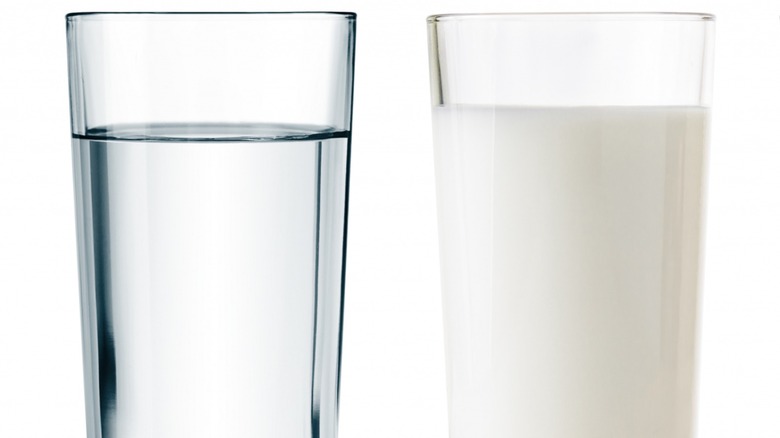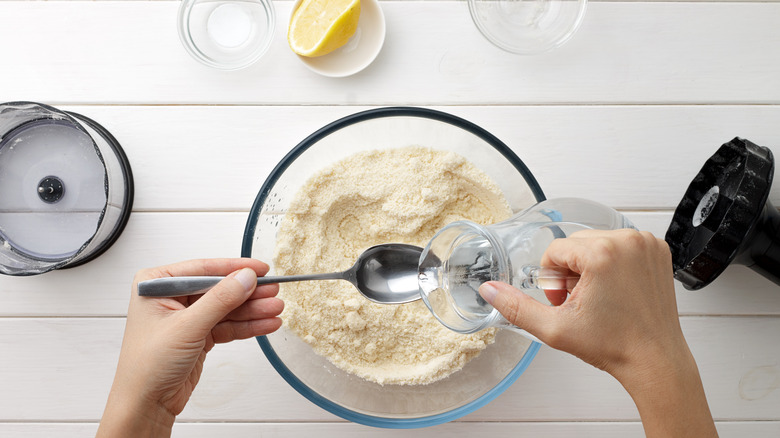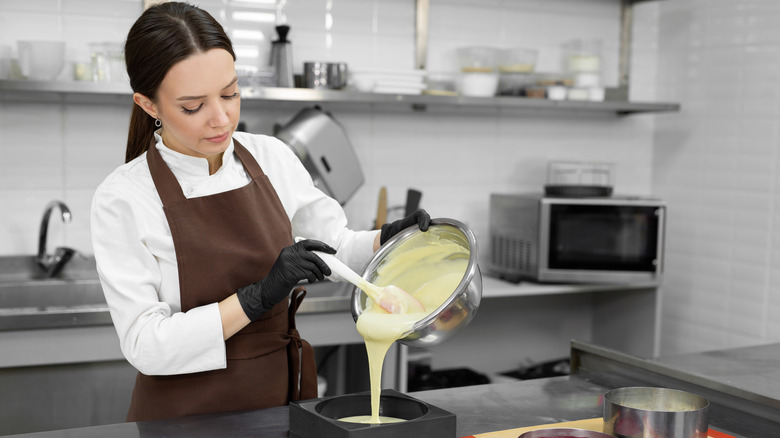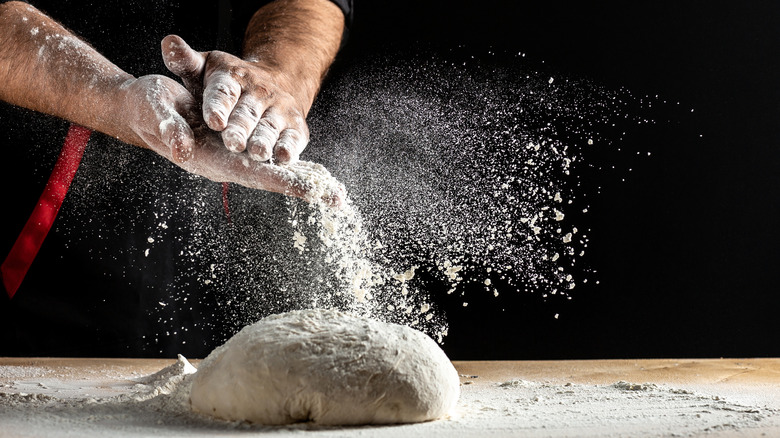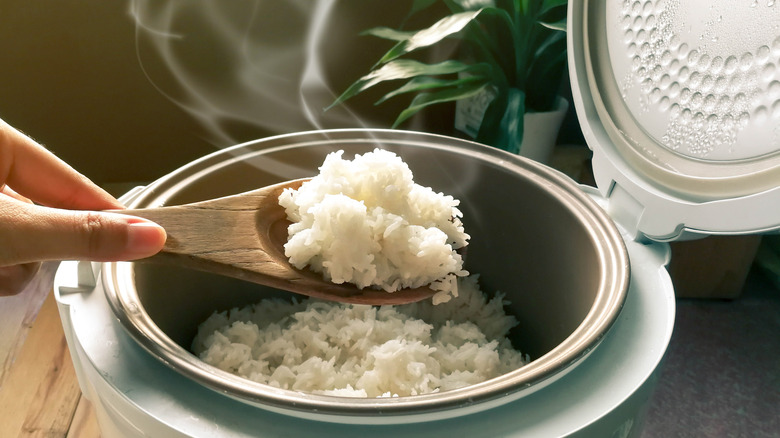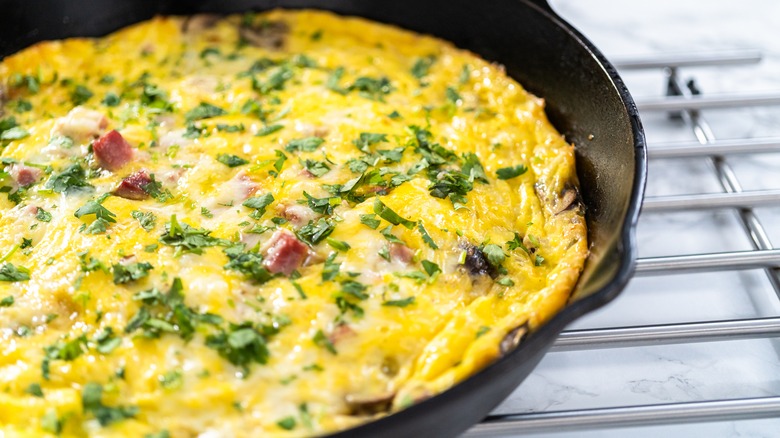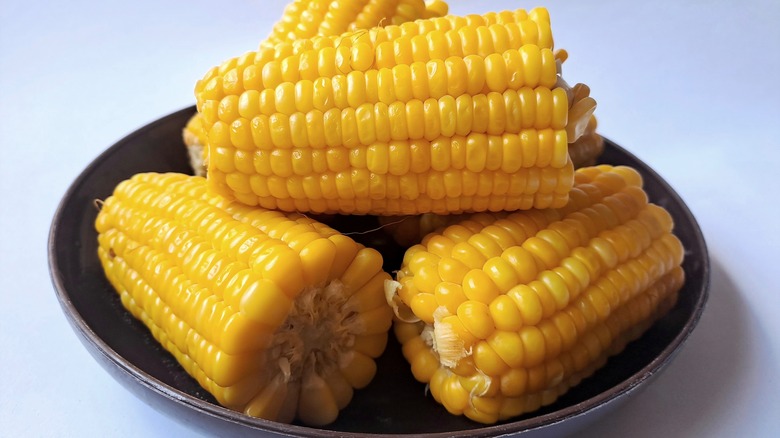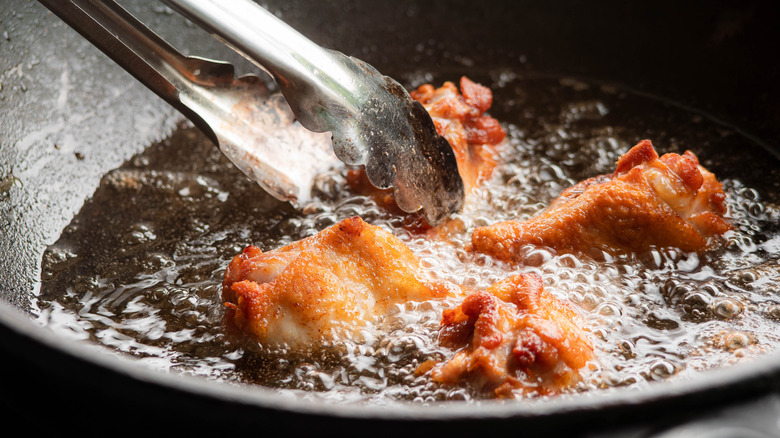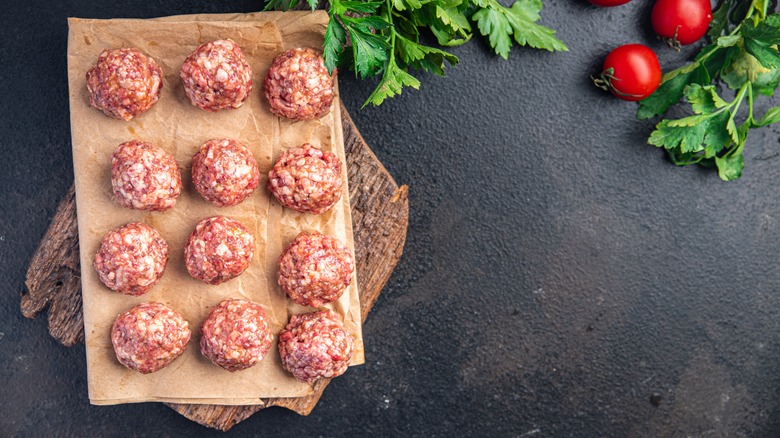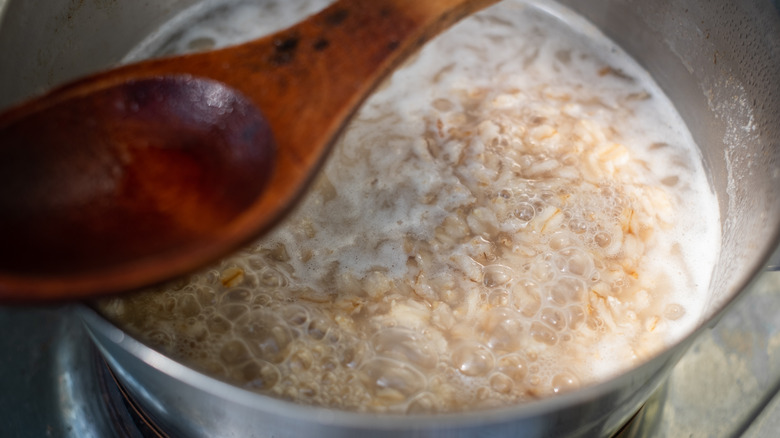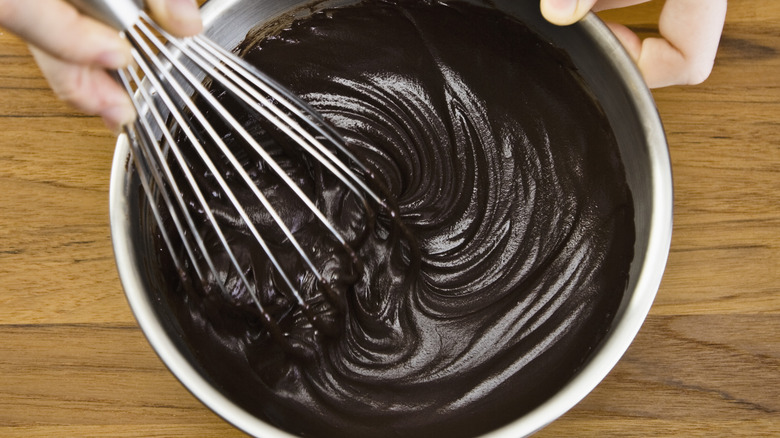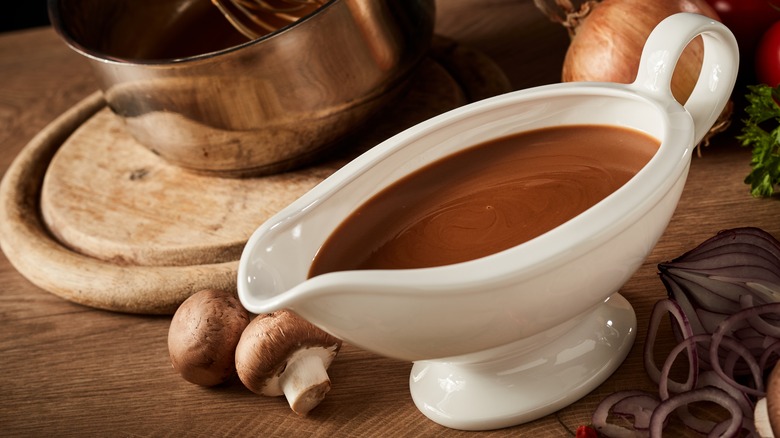When You Should Use Water Or Milk When Making These Foods
Water and milk are two of the most common ingredients you'll find in a recipe. Since both serve as a liquid component, it's natural to wonder if they're interchangeable. Technically, the answer is yes. In just about every circumstance you could swap one for the other and end up with a dish that looks pretty similar to the original. But, if you've ever eaten a bowl of cereal with water instead of milk, you know that "similar" doesn't mean "same" and more importantly, that "could" doesn't mean "should."
Milk and water each have unique properties that can lead to surprisingly different results in flavor and texture even if it's the only ingredient you changed. Understanding the function of both milk and water in cooking is the first step to illuminating this disparity. Then, we'll examine which of the two liquids is ideal when preparing various popular foods to help assist you in making the best possible version.
The purpose of milk in cooking and baking
Milk is a versatile ingredient that can pull off quite a few cool tricks in the kitchen. Lactose, a form of sugar in dairy, caramelizes well and helps produce a nice browning on breads and pastries, as well as thicken sauces or soups. According to the "Chemistry of Cooking," lactose doesn't add any noticeable sweetness of its own. This makes it a handy ingredient when you want to obtain caramelizing effects without adding excessive sweetness, such as in savory recipes, breads, or pie crusts.
Meanwhile, the proteins and fats in milk help stabilize air bubbles when you foam it up, such as for a cappuccino or whisking milk into eggs. In baking, that ability to form and retain bubbles allows breads and cakes to hold more of the gasses that are released, creating a fluffier end result.
Meanwhile, milk's fat content creates a softer texture and richer flavor. It even extends the shelf life of baked goods by keeping them light and fresh for longer. Keep in mind that skim milk won't have quite the same benefits since it doesn't have the necessary fat.
The purpose of water in cooking and baking
Water may not seem like it could pull off any cool tricks, but you'd be surprised. It's the key to airy, chewy textures like a baguette or pizza crust because it turns into steam when heated and helps create big air bubbles. When the steam releases from the dough into the oven, it creates a glossy, hard crust (via King Arthur Baking).
Unless alkaline, water is also slightly more acidic than milk. The acidity won't impact the flavor, but it's enough to increase yeast activity which enhances the fermentation process. This makes it the preferred choice for sourdough and other types of bread that call for the aroma and flavor of a well-fermented dough.
Water is also a solvent, meaning it dissolves sugar and minerals like salt, as well as other soluble ingredients in your dish. So it's important in dishes where you want a sharper or more complex flavor profile. When you combine this with its ability to transform into steam, you have a pretty impressive cooking medium.
Water can also pull out all the flavors of your dish and then evaporate, leaving just the intensified flavors behind. This is what is happening when you reduce a sauce or stew. It is also a handy feature when you're caramelizing onions. Add a cup or so of water to your onions, put the lid on, and the steam will kick-start the softening and browning process so you can caramelize your onions faster.
Cake
Almost every cake recipe you find is going to call for milk, which makes sense considering its ability to create a tender crumb and richer flavor profile — two characteristics you generally want in a cake. That's hard to recreate with any other substitutes because the lactose in milk plays a big part in producing those effects. So, the rule of thumb is to almost always opt for milk in your cakes.
The one exception is if you are making a cake with a sharper flavor profile. Bakers often swap the milk for water when making ginger, spice, and sometimes even chocolate cakes. Since water acts as a solvent, it draws out the flavors of the spices or chocolate without adding a layer of creaminess that can muddy them as milk does. Think about the difference between a bar of milk and dark chocolate. Without the milk, the chocolate just tastes more chocolatey. The same is true with cake. Without the milk, the other flavors of the cake can shine more brightly.
Bread
Milk and water both show up pretty frequently in bread recipes, but the results they produce are distinct. Water shines when you're making crusty, chewy loaves to serve steaming hot right out of the oven, like pizza dough or garlic bread. It's also your best friend for making bread that ferments over a long time, like sourdough, because it helps speed up fermentation activity, per King Arthur Baking.
Milk, on the other hand, is the winner when making softer bread, like dinner rolls or buns. The lactose and fat that create a tender cake crumb also result in a tender loaf of bread. Similarly, it's a good pick for a loaf that you aren't planning to polish off the same day you bake it. Milk can keep your bread from going stale as quickly as a loaf baked with water. If you're making sandwich bread that you want to use over the course of a week, for example, use milk.
Rice
For most cooks, rice is made with water and only water. If milk is added, it's at a later stage as part of a sauce. There's a good reason for this: Water preserves the structure of the grains and makes for a finished product that can be readily mixed in with other ingredients or used to absorb the excess sauces and juices from a dish.
According to culinary scientist Jessica Gavin, water helps regulate the cooking process when cooking rice covered at a low simmer. The steam stabilizes the temperature and the gentle simmer prevents starches from escaping and creating a sticky end result.
If you're making a sweet dish, on the other hand, it's a whole different story. Milk replaces water in most desserts that use rice. While cooking, the fat and protein from the milk and the starches from the rice work together to create an almost custard-like texture that's perfect for a rice pudding or other creamy rice dessert. These recipes are generally baked instead of being cooked over the stove or in a rice cooker.
For savory dishes, though, stick with water. Better yet, switch to broth. The texture at the end will be the same but it's so much more flavorful than plain water.
Eggs
In most of your quick stove-top methods for cooking eggs, you generally want to avoid both milk and water. There's usually not enough time to cook off the extra moisture, resulting in eggs that are somehow both rubbery and runny. A fairly well-known hack some cooks swear by is adding a splash of milk to eggs before whisking them. It's supposed to lend a creaminess to the eggs and help fluff them up. But in the short time that eggs spend in the pan when scrambling or making an omelet, the milk doesn't really have time to fuse into the dish to create a creamy texture.
Meanwhile, adding plain water to your eggs can leverage the steaming effect to slow down the cooking process and create a fluffier egg without the same risk of overheating. To pull it off, lower the temperature a smidgen from the usual so that you have time to cook off the excess moisture without burning the eggs.
With slower cooking methods, milk has a chance to work its magic without risking damage. When baking, for example, milk and egg combine into a decadent custard-like texture which is what makes the perfect frittata or quiche — and, incidentally, the perfect custard. If you tried substituting water for the milk in these dishes, your custard wouldn't set and your quiche or frittata would be on the crumbly side.
Pasta
You might think pasta should only be boiled in water and that anything else would be unthinkable. And for the most part, you'd be right. If the pasta is going to end up with a tomato-based or other non-dairy sauce, stick with water. The same is true if you're planning to just dump out the liquid the pasta was cooked in, rather than adding a ladleful of the starchy stuff to your sauce to thicken it.
With that said, there is a little-known case for boiling pasta in milk: creamy dishes. The most common place you'll see this technique is with macaroni and cheese. In most versions, you double the milk you'll use for the sauce to account for the fact that a lot will be absorbed by the pasta and then just boil the macaroni directly in it. Once cooked, strain the milk into a saucepan and combine it with a roux to make the cheese sauce.
The benefit here is that you're keeping all the starchy goodness that makes pasta water so valuable in your final sauce. Another benefit is that the macaroni becomes creamier from the inside out because it absorbs milk instead of water. You can use this technique for Alfredo or any other creamy pasta dish where milk is already a player.
Corn on the cob
Corn on the cob is another dish where you might think of water as your only option. But, especially in the South, some cooks prefer to boil their corn in a mixture of milk and butter. The milk infuses into the kernels so that you end up with a creamier, richer, and more tender finished product.
It's so creamy, in fact, you might even skip the butter you usually slather on top. Just add a sprinkle of salt and enjoy. If you want a side that marries the richness of creamed corn with the crispness of corn on the cob, boiling the ears in milk does the trick. Use a mixture of water and milk if you don't love the idea of dumping a whole pot of milk down the drain after cooking the corn.
For those who prefer more snap than softness in their corn kernels, stick with water. It won't soften the skin as much as milk does and also won't interfere with corn's natural flavor. So it's ideal when you want a bright, fresh corn flavor to add to a salad or on top of chili.
Fried chicken and other battered foods
When frying foods like chicken or fish, you typically coat them in a mixture of flour and some kind of liquid. The liquid is most often milk if you're in the United States. According to Livestrong, the batter is more likely to stick when it is assisted by proteins in milk. Meanwhile, the lactose and fat also turn the outside golden brown while frying. Unlike cream or eggs, milk is still relatively thin so it's less likely to create a breading that's too thick or soggy.
In Japan, though, batters are typically made with water. A high-starch flour or a mix of flour and cornstarch is mixed with ice-cold water. Then, the food is immediately dipped and fried. Instead of sticking to the food like milk, the water quickly becomes steam which gently cooks the food before evaporating away. The end result is an extra crispy, airy fried dish. The delicate crust is enough to give you the crisp texture but not so heavy that it overpowers the food it's coating.
Both water and milk result in delicious fried chicken, so it really just comes down to personal preference. If your favorite part of fried chicken is the breading, use milk for a thicker but still crisp crust. But if you just want enough breading to contrast with the juicy, tender texture of the chicken, use water.
Meatballs
Not all meatball recipes call for milk or water, but some cooks add a splash of either to prevent the mixture from drying out and becoming crumbly. When using water, the steam can help cook the meatball from the inside without adding any density, resulting in a perfectly light and tender consistency. Remember that water is also a solvent so it can help develop any herbs and spices you added, causing them to intensify along with the flavor of the meat.
Another kitchen hack is to wet your hands with water before rolling the meatballs so the meat doesn't stick to them. You'll get a more evenly shaped ball, and the excess water cooks off almost instantly in the pan so you won't upset the ratio of wet and dry ingredients.
While water does a great job, some cooks swear by milk. It adds moisture and tenderness and the proteins also act as a mild binding agent to hold the meatball together. In fact, some recipes even suggest skipping the egg and just using milk as your binder because it eliminates the risk of the egg overcooking and turning the meatball into a dense sponge. However, it's not as strong a binding agent as an egg, so this swap usually requires mixing the milk with chia seeds, bread, or another thickener to create a similar consistency (via Flavorful Home). According to eHow, in this case, you're better off baking instead of pan-frying the meatballs to minimize breakage.
Oatmeal
Most people add a splash of milk when their oatmeal is almost done cooking to cool it down and add some creaminess, but home cooks are pretty divided on whether you should cook the oats in milk from the start. Oatmeal cooked in plain water isn't particularly exciting. It's bland and requires a lot of sweetening to change that fact. However, water does preserve the integrity of the oats a lot better. So, from a texture perspective, water wins.
Cooking oatmeal in milk, on the other hand, adds a rich, creamy base that's easy to finish off with a drizzle of honey or a sprinkle of sugar. You won't need to add nearly as much sweetener or seasonings as you do with plain water-cooked oats because the milk provides such a strong foundation. The trade-off is in texture; your oats will become a little gummy or goopy compared to their water-cooked counterparts. For some people, it's worth it.
For others, the answer to water's blandness is to swap it with tea, not milk. Cooking oatmeal in tea, especially a masala chai or other spiced blend, infuses the oats with a desperately-needed base of flavor that you can build on with cinnamon, honey, brown sugar, or your favorite add-ons.
Icing
Let's start by defining icing. The terms frosting, icing, and glaze get used interchangeably because, honestly, they're more or less the same ingredients but in different proportions. Frosting is thick and solid enough to be piped into decorative shapes and borders. A glaze, on the other hand, is so thin and runny that it's almost transparent, so it gets drizzled rather than spread. Icing is somewhere in between; it's runny enough that you could pour it but thick enough that you can spread it for a more even coating.
When you use water, you get a thinner, more pourable icing that's closer to a glaze. Being a solvent, water is also a good base when you're adding vanilla extract, cocoa powder, or another flavor that you really want people to notice when they take a bite. Finally, water dissolves sugar more effectively which is useful if you want to make sure you have a smooth, rather than a gritty finish (via Food Crumbles).
When you use milk, the icing will have a slightly thicker and creamier consistency. This makes it a little more spreadable since it won't run down the sides as quickly, but it should still harden into a layer that's closer to a glaze than a frosting. In terms of taste, it's ideal for making a richer icing with a more neutral flavor profile, like vanilla rather than a lemon drizzle.
Gravy
Gravy is split into two broad categories, white gravy and brown gravy, both of which start with meat drippings. The distinction hinges almost entirely on which liquid you add to those drippings. White gravy is made with milk or some kind of cream, while brown gravy is made with water or broth.
White gravy, as you can imagine, is richer and creamier. Thicker gravy is usually meant to be the star of the dish, not an accent, so it's not uncommon to find chunks of sausage or bacon mixed in. Bulked up, it's usually served on top of biscuits or another base that's really just there to help you sop up the gravy. Less meaty versions show up as a dip or drizzle for fried chicken or steak.
Brown gravy is a little runnier by comparison but still has a viscous consistency similar to caramel. It's often served on top of starchy or absorbent foods like mashed potatoes, mushrooms, or rice, but it's also great for jazzing up milder meats like pork or turkey. What it lacks in creaminess, it more than makes up for in umami thanks to water's ability to draw out the flavors of the ingredients cooked in it. That also makes brown gravy a great platform for experimenting with different herbs and seasonings.
